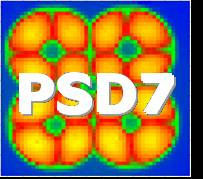Speaker
Dr
Junko Kohagura
(Plasma Research Centre, University of Tsukuba)
Description
Recent findings of the importance of radially sheared electric-field
formation in plasmas enhance the requirements of spatial-profile
measurements of ion-confining potentials and ion-current signals
simultaneously. For instance, the frequency analyses of end-loss ion-
energy spectrometer arrays (IES) signals show the existence of
electron drift waves, giving a peaked structure over a few kHz and
turbulence-like fluctuations without any coherent azimuthal phasing
relation below a few kHz during a weaker sheared period. On the
other hand, some finite levels of turbulent fluctuations and
remarkable suppression of turbulence are found during a stronger
sheared period with ECH. This encourages the usefulness of
potentials and radial electric-field shear for confinement
improvements.
For the purpose of observations of these important parameters, we
have been developing several types of multigridded electrostatic ion-
energy spectrometers and ion-current detectors because of their
compact-sized simple structures and convenient handling without the
effects on the plasma-confining magnetic fields of the plasma
device. These ion-diagnostics are proposed to obtain precise ion-
energy spectra and absolute values of ion currents without any
perturbations from simultaneously incident energetic electrons into
the arrays. For instance, the ion-current detector consists of a set
of parallel metal plates with respect to lines of ambient magnetic
forces of a plasma device for analyzing incident ion currents along
with a grid for shielding the collector against strays due to the
metal-plate biasing. One of the most essential characteristic
properties of the proposed detector is based on the physics
principle of a “self-collection” mechanism for suppressing the
effects of secondary-electron emission from a metal collector.
Availability of the detector is clearly demonstrated in the GAMMA10
plasma experiments.
Primary author
Dr
M Hirata
(Plasma Research Centre, University of Tsukuba,)
Co-author
Dr
Junko Kohagura
(Plasma Research Centre, University of Tsukuba)
